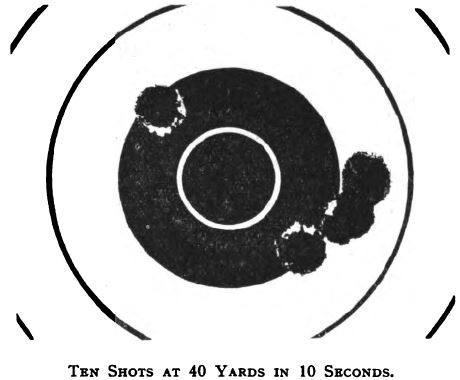
Winchester 351 Self Loading Rifle
Editorial and Publishing Offices: EFFINGHAM
HOUSE ARUNDEL
STREET, STRAND, LONDON, W.C.
https://books.google.com/books?id=pvZYAAAAYAAJ&pg=PA127&dq=%22WINCHESTER+351%22&hl=en&sa=X&ved=0CCwQ6AEwA2oVChMIrpGCgZypxwIVwgiSCh1oTQ3L#v=onepage&q=%22WINCHESTER%20351%22&f=true
Arms & Explosives, vol 15, no. 181, Oct 1907 pages 130-131

This is a weapon which has hardly received the attention that its technical importance seems to justify. The explanation for its apparent neglect may possibly rest in the circumstance that the public regard the production of well thought out rifle mechanism as a part of the ordinary routine business of the Winchester Arms Company. When they brought out their automatic .22 calibre rifle some years ago they received full credit for the interesting departure which had been registered, but the subsequent models firing more powerful cartridges on the same self-loading principle have been taken more for granted that the circumstances warrant. The recent Bisley Meeting afforded an excellent opportunity for demonstrating the extraordinary efficiency of the self-loading action.
Eleven out of 15 places in this competition were won with the Winchester Automatic Rifle, and no hitch occurred during any part of the shooting. Inconceivable as it may seem one of the competitors in the event which was open to all automatic rifles succeeded in the course of one minute in getting off 53 aimed shots, 47 of which hit the target. Some idea of the merit of this performance can be gained from our own humble attempt to apply a somewhat similar kind of test to the rifle as a self-loading arm, and the accompanying target shows the result.

It should be explained that Mr. Nelson, the winner of the Bisley competition, used the -32 automatic, whereas our own test was conducted with the .351 high-power rifle firing the cartridge here illustrated. Our test consisted in charging the magazine with five cartridges, and operating the plunger so as to pass No. 1 round into the chamber. Careful aim was taken from a gunmaker's table rest at the bullseye here reproduced, the distance being 40 yards. The first shot was aimed with due deliberation, and then four others were rattled off as quickly as the aim could be recovered after each shot had been fired. The time elapsing between the firing of the first and the fifth rounds was carefully noted, and the period occupied was in every instance ten seconds. At the third attempt familiarity with the somewhat unusual conditions had been gained, and the accompanying remarkably fine target was produced.
The isolated shot was No. 1 round, and those making a single hole on the lower right-hand edge of the bull were fired during an average time interval of two-and-a-half seconds. So quickly was the rifle manipulated that it seemed inconceivable for any material gain in rapidity of aimed shooting to be registered, yet we are faced with the circumstance that Mr. Nelson fired ten times our number of shots in five times as long, with the added operation of substituting a full magazine for the exhausted one at the end of every five rounds. The aiming of the first shot from the full magazine, the time for which was excluded from our own record, must also be taken into account.

Where long strings of shots have to be fired under competitive conditions the shooter soon learns to avoid the delay incidental to the preliminary working of the spring plunger for seating the first cartridge in the chamber. This delay is obviated by inserting a spare cartridge in the chamber, afterwards introducing the filled magazine. The shooter then fires five shots, the sixth being left in the chamber in readiness for the next series, the empty magazine being replaced by a full one. The Bisley competition is of course of chief interest as showing the reliability of the mechanism and its capacity under military conditions of test. The sportsman is, however, only interested to know that his five shots are safe to go off properly, for these give him the rapidity of manipulation of a double barrel gun, with the advantage of five rounds instead of two. The most enthusiastic advocates of ordinary magazine rifles for sporting use have always been forced to admit that the two discharges in quick succession of a double barrel gun are of greater sporting value than five rounds from a magazine, with a time interval and disturbance of aim between the shots.
